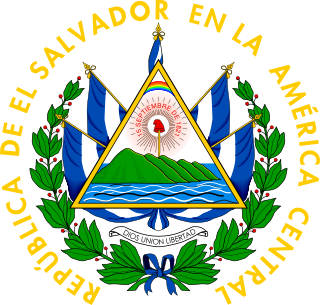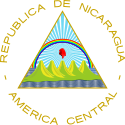
The Sandinista National Liberation Front is a Christian socialist political party in Nicaragua. Its members are called Sandinistas in both English and Spanish. The party is named after Augusto César Sandino, who led the Nicaraguan resistance against the United States occupation of Nicaragua in the 1930s.

Legislative elections were held in El Salvador on 20 March 1988. The result was a victory for the Nationalist Republican Alliance, which won 31 of the 60 seats. Voter turnout was 59%.
The Luisa Amanda Espinoza Association of Nicaraguan Women was initially established in 1977 under the name Association of Women Concerned about National Crisis. AMPRONAC was part of the Sandinista (FSLN) network which was set on bringing down the Anastasio Somoza Debayle regime in 1979. Shortly after the fall of Somoza, AMPRONAC change its name to AMNLAE, after Luisa Amanda Espinoza, the first women to die in the war against Somoza, but remained closely connected to the FSLN as their slogan suggests: "No revolution without women's emancipation: no emancipation without revolution."

Presidential elections were held in El Salvador on 20 February 1972. The result was a victory for Arturo Armando Molina of the Party of National Conciliation (PCN), who received 43% of the vote. However, the election was characterised by massive fraud. The PCN had faced a strong challenge from left- and right-wing opposition, and as a result had tried to rig the election by holding the presidential elections two weeks before the legislative election to ensure that if Molina failed to pass the 50% mark, the Legislative Assembly would still be under PCN control to approve him as president. Despite their attempts to stuff ballot boxes, it looked for a while as though José Napoleón Duarte of the opposition National Opposition Union had been victorious after the Central Election Board in San Salvador issued a statement that Duarte had won by around 6,000 votes. However, this was followed by a three-day news blackout, after which a revised set of figures was announced giving a narrow victory to Molina, meaning that the Legislative Assembly would choose the president. The opposition walked out of the vote, resulting in Molina being elected by 31 votes to zero.
General elections were held in Honduras on 28 March 1971. Voters went to the polls to elect a new President of the Republic and a new Congress. The two main parties, the National Party and Liberal Party, had agreed before the election to split the Congressional seats equally between them, with each party being awarded 32 of the 64 seats. Additional one seat was to be allocated to the winner of the presidential elections as the president was entitled to one seat in parliament, while both parties were to be equally represented in the Supreme Court in all state institutions including the Government. Ramón Ernesto Cruz Uclés of the National Party won the presidential election with 53% of the vote. Approximately 40% out of total of around 900,000 voters abstained from voting at the elections. Some of the major topics at the elections was the issue of commitment to continued participation in the Central American Common Market and approach to the relations with El Salvador after the Football War.

Constituent Assembly elections were held in Honduras on 12 February 1965. The Constituent Assembly subsequently elected Oswaldo López Arellano as president.

Constituent Assembly elections were held in Honduras on 7 October 1956. Prior to the elections, President Julio Lozano Díaz established his own party, the Party of National Unity. The elections were allegedly heavily rigged and the PUN won all 58 seats.

General elections were held in Honduras on 10 October 1954. The elections were relatively honest. and saw Ramón Villeda Morales of the Liberal Party emerge as the most popular presidential candidate with 48% of the vote. However, the constitution required Congress to confirm the president if no candidate received a majority in the popular vote. The Liberals did not have a majority in Congress, and the National Party and National Reformist Movement (MNR) agreed to block Villeda's candidacy, although they were unable to agree on a candidate of their own. The two parties boycotted the confirmation session in November – an idea proposed by US Ambassador Whitting Willauer – meaning those present did not form a quorum.

General elections were held in Nicaragua on 4 November 1984, to elect a president and parliament. Approximately 1.2 million Nicaraguans voted, representing a 75% turnout, with 94% of eligible voters registered. Impartial observers from international groupings such as the European Economic Community, religious groups sent to monitor the election, and observers from democratic nations such as Canada and Ireland concluded that the elections were generally free and fair.

General elections were held in Nicaragua on September 1, 1974, to elect a president and National Congress of Nicaragua.

General elections were held in Nicaragua on February 3, 1963 to elect a president and National Congress.

General elections were held in Nicaragua on 3 February 1957 to elect a president and National Congress.
Luis Somoza Debayle formalized his grip on the presidency through fraudulent elections in February 1957 which were boycotted by all the opposition except the puppet Conservative Nationalist Party (PNC). The Popular Social Christian Party (PPSC) was created in reaction to these elections and received support from younger Conservatives dissatisfied with their party’s inability to make any political impact on the dictatorship.

General elections were held in Nicaragua on 2 February 1947 to elect a president and National Congress.

General elections were held in Nicaragua on 8 December 1936 to elect a President, half of the Deputies and one-third of the Senators of the National Congress.

General elections were held in Nicaragua on 6 November 1932 to elect the president, half of the seats in the Chamber of Deputies and one-third of the seats in the Senate of the National Congress.

General elections were held in Nicaragua on 4 November 1928 to elect a president, half of the deputies and a third of the senators of the National Congress.

Presidential elections were held in Nicaragua on 11 November 1926.

General elections were held in Nicaragua on 5 October 1924 to elect a president, half of the deputies and one-third of the senators of the National Congress.
In 1979, the Sandinista National Liberation Front (FSLN) overthrew Anastasio Somoza Debayle, ending the Somoza dynasty, and established a revolutionary government in Nicaragua. Following their seizure of power, the Sandinistas ruled the country first as part of a Junta of National Reconstruction. Following the resignation of centrist members from this Junta, the FSLN took exclusive power in March 1981.

The Traditional Conservative Party, was a Nicaraguan political party founded in the first half of the 19th century as the Conservative Party.






